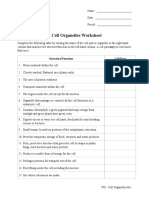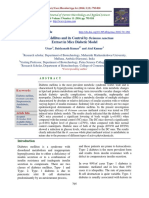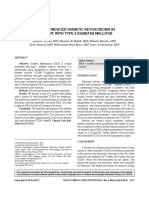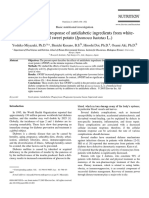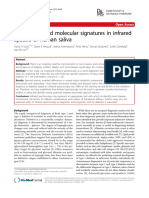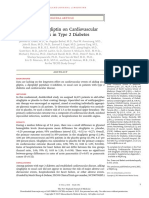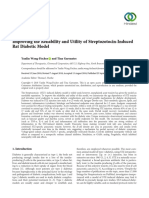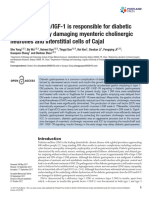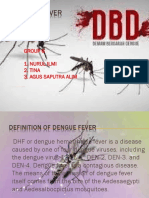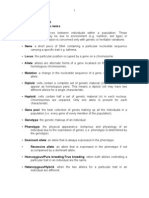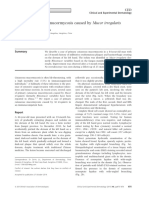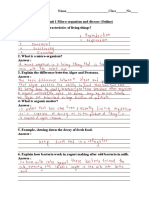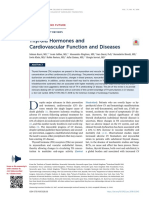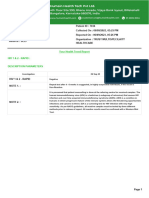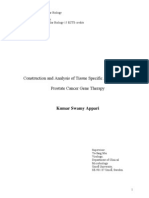Yyy
Yyy
Uploaded by
devy diantieCopyright:
Available Formats
Yyy
Yyy
Uploaded by
devy diantieOriginal Description:
Original Title
Copyright
Available Formats
Share this document
Did you find this document useful?
Is this content inappropriate?
Copyright:
Available Formats
Yyy
Yyy
Uploaded by
devy diantieCopyright:
Available Formats
The New England
Journal of Medicine
© Co py r ight, 2 0 0 0 , by t he Ma s s ac h u s e t t s Me d ic a l S o c ie t y
V O L U ME 3 4 2 F E B R U A R Y 3, 2000 NUMBER 5
A NOVEL SUBTYPE OF TYPE 1 DIABETES MELLITUS CHARACTERIZED BY
A RAPID ONSET AND AN ABSENCE OF DIABETES-RELATED ANTIBODIES
AKIHISA IMAGAWA, M.D., TOSHIAKI HANAFUSA, M.D., PH.D., JUN-ICHIRO MIYAGAWA, M.D., PH.D.,
AND YUJI MATSUZAWA, M.D., PH.D., FOR THE OSAKA IDDM STUDY GROUP*
T
ABSTRACT YPE 1 diabetes mellitus is caused by loss of
Background and Methods Type 1 diabetes mellitus insulin-secreting capacity due to selective
is now classified as autoimmune (type 1A) or idio- autoimmune destruction of the pancreatic
pathic (type 1B), but little is known about the latter. beta cells.1,2 Insulitis (i.e., mononuclear-cell
We classified 56 consecutive Japanese adults with infiltration of the pancreatic islets) is the direct result
type 1 diabetes according to the presence or absence of the autoimmune process. Antibodies to the cyto-
of glutamic acid decarboxylase antibodies (their pres- plasm of islet cells, glutamic acid decarboxylase, in-
ence is a marker of autoimmunity) and compared their sulin, and tyrosine phosphatase–like protein (IA-2 or
clinical, serologic, and pathological characteristics.
IA-2b), which appear before the clinical onset of dia-
Results We divided the patients into three groups:
36 patients with positive tests for serum glutamic acid
betes, are good markers of the autoimmune process.1,2
decarboxylase antibodies, 9 with negative tests for Several lines of evidence have suggested that auto-
serum glutamic acid decarboxylase antibodies and immunity is not the only cause of beta-cell destruc-
glycosylated hemoglobin values higher than 11.5 per- tion. We and others have described young patients
cent, and 11 with negative tests for serum glutamic who presented with the abrupt onset of symptoms of
acid decarboxylase antibodies and glycosylated he- hyperglycemia and who were prone to the develop-
moglobin values lower than 8.5 percent. In compar- ment of ketoacidosis, as is characteristic of patients
ison with the first two groups, the third group had a with type 1 diabetes, but who did not have insulitis on
shorter mean duration of symptoms of hyperglyce- either biopsy3-5 or autopsy.6,7 Furthermore, at least 10
mia (4.0 days), a higher mean plasma glucose con- percent of patients with newly diagnosed type 1 di-
centration (773 mg per deciliter [43 mmol per liter])
in spite of lower glycosylated hemoglobin values, di-
abetes do not have any diabetes-related antibodies.8,9
minished urinary excretion of C peptide, a more se- The American Diabetes Association and the World
vere metabolic disorder (with ketoacidosis), higher Health Organization have proposed that type 1 diabe-
serum pancreatic enzyme concentrations, and an ab- tes be subdivided into autoimmune (immune-medi-
sence of islet-cell, IA-2, and insulin antibodies. Immu- ated) diabetes (type 1A) and idiopathic diabetes with
nohistologic studies of pancreatic-biopsy specimens beta-cell destruction (type 1B).10,11 However, the spe-
from three patients with negative tests for glutamic cific characteristics of the idiopathic subtype are large-
acid decarboxylase antibodies and low glycosylated ly unknown. In a previous study,5 we found that the
hemoglobin values revealed T-lymphocyte–predom- presence of glutamic acid decarboxylase antibodies,
inant infiltrates in the exocrine pancreas but no insuli- but not islet-cell antibodies, was closely correlated
tis and no evidence of acute or chronic pancreatitis.
with direct evidence of insulitis in patients with type 1
Conclusions Some patients with idiopathic type 1
diabetes have a nonautoimmune, fulminant disorder
diabetes. In this report, we describe the results of
characterized by the absence of insulitis and of dia- detailed clinical and histologic studies of patients with
betes-related antibodies, a remarkably abrupt onset, idiopathic type 1 diabetes.
and high serum pancreatic enzyme concentrations.
(N Engl J Med 2000;342:301-7.)
©2000, Massachusetts Medical Society. From the Department of Internal Medicine and Molecular Science,
Graduate School of Medicine, Osaka University, Osaka, Japan. Address re-
print requests to Dr. Imagawa at the Department of Internal Medicine and
Molecular Science, Graduate School of Medicine, B5, Osaka University, 2-2
Yamadaoka, Suita 565-0871, Japan, or at imagawa@imed2.med.osaka-u.ac.jp.
*Other members of the Osaka IDDM Study Group are listed in the Ap-
pendix.
Vol ume 342 Numb e r 5 · 301
The New England Journal of Medicine
Downloaded from nejm.org on October 14, 2019. For personal use only. No other uses without permission.
Copyright © 2000 Massachusetts Medical Society. All rights reserved.
The Ne w E n g l a nd Jo u r n a l o f Me d ic i ne
METHODS 20
Patients
We studied 56 consecutive patients with type 1 diabetes who
came to our hospitals within one year after receiving the diagnosis,
during the period from 1994 to 1998. All 56 patients met the cri- 18
teria of the American Diabetes Association for type 1 diabetes —
that is, pancreatic beta-cell destruction as the primary cause of the
disorder and a tendency toward ketoacidosis10,11 — as determined
by at least two physicians independently. Patients who had a period
of remission that lasted for six months or more after the diagnosis 16
had been made were excluded.12 None of the enrolled patients con-
sumed moderate or large amounts of alcohol. The study was ap-
proved by the ethics committee of Osaka University Medical Hos-
Glycosylated Hemoglobin (%)
pital, and written informed consent was obtained from each patient.
14
Clinical Characteristics and Serum Glutamic Acid
Decarboxylase Antibodies
At the time of the onset of overt diabetes, all patients were hos-
pitalized. Their clinical characteristics were recorded, and plasma
glucose, serum electrolytes, arterial pH, glycosylated hemoglobin, 12
and serum total or pancreatic amylase and elastase I were measured
within two days after the initial diagnosis, and an ultrasonograph-
ic study of the pancreas was performed. Patients with arterial pH
values lower than 7.35 and serum bicarbonate concentrations low-
er than 18 mmol per liter received the diagnosis of metabolic ac- 10
idosis. Urinary C-peptide excretion was measured daily for at least
three days, and the mean value was calculated. Subsequently, all
patients underwent clinical examinations and measurements of gly-
cosylated hemoglobin at monthly intervals.
The patients were divided into two groups according to the 8
presence or absence of glutamic acid decarboxylase antibodies in
serum samples obtained within three months after the initial di-
agnosis of diabetes, with the use of a radioimmunoassay kit (Rip-
GAD, Hoechst Japan, Tokyo, or GAD-Ab Cosmic, Cosmic, To-
kyo). A value greater than 5 units per milliliter (with the first kit) 6
or 1.5 units per milliliter (with the second) was considered posi-
tive. The specificity and sensitivity of the first kit were 100 per-
cent and 89.5 percent in the Second International GADAb Work-
shop, respectively,13 and the specificity and sensitivity of the second
kit were both 100 percent in the Second and Third GAD Proficien- 4
cy Test Results Evaluations (University of Florida, Gainesville). Positive Negative
GAD Antibodies
Diabetes-Related and Thyroid Antibodies
Figure 1. Glycosylated Hemoglobin Values at the Time of the Di-
Serum antibodies were measured within three months after the
agnosis of Diabetes in 56 Patients, According to Whether the
initial diagnosis of diabetes. Islet-cell antibodies were measured
Test for Glutamic Acid Decarboxylase (GAD) Antibodies Was
by an indirect immunofluorescence method (with an abnormal
Positive or Negative.
value defined as more than 5 Juvenile Diabetes Foundation units),4
IA-2 antibodies with an immunoprecipitation assay kit (with an The values for glycosylated hemoglobin in the patients with
abnormal value defined as more than 0.75 unit per milliliter) (Cos- positive antibody tests are scattered, whereas the values in the
mic),14 and insulin antibodies with a liquid-phase radioimmuno- patients with negative antibody tests are clearly divided into
assay (with an abnormal value defined as higher than the 99th two groups: those below 8.5 percent and those above 11.5 per-
percentile for 140 normal subjects).15,16 Thyroid antimicrosomal cent. The broken line indicates the upper limit of the normal
antibodies were measured by a hemagglutination assay (with an range for glycosylated hemoglobin.
abnormal value defined as greater than 1:100).17
HLA Typing and Mitochondrial-DNA Analysis
Genomic and mitochondrial DNA were extracted from periph- used with monoclonal antihuman CD3+ T-lymphocyte antibody,
eral-blood leukocytes. The HLA class II antigen haplotype and the B-lymphocyte antibody, or macrophage antibody and anti-insulin
presence or absence of a guanine-for-adenine substitution at po- or anti-glucagon antibodies. We also examined the expression of
sition 3243 in mitochondrial DNA were determined.5,18 No mi- major histocompatibility complex (MHC) class I antigens in islets
tochondrial mutations were detected. with the use of antihuman HLA-A, B, and C antibodies. The sourc-
es of these antibodies have been reported previously.4
Pancreatic Studies
To examine the relation between lymphocytes or macrophages
Pancreatic biopsies were performed in six patients within five and pancreatic exocrine tissue, we stained the cells with peroxi-
months after the initial diagnosis of diabetes, as reported previ- dase substrate solution containing diaminobenzidine tetrachloride–
ously.3-5 The biopsy specimens were examined after staining with nickel chloride (Zymed Laboratories, South San Francisco, Calif.).
hematoxylin and eosin and by indirect immunohistochemical meth- The sections were then incubated with antihuman alpha-amylase
ods. To detect insulitis, a double immunofluorescence method was antibody (Sigma Chemical, St. Louis), and the pancreatic exocrine
302 · Febr u ar y 3 , 2 0 0 0
The New England Journal of Medicine
Downloaded from nejm.org on October 14, 2019. For personal use only. No other uses without permission.
Copyright © 2000 Massachusetts Medical Society. All rights reserved.
A N OV E L SUBT YP E OF T YP E 1 DIABET E S MELLITUS WITH A N A B S ENCE OF D IA B ETES -REL ATED A NTIB OD I ES
TABLE 1. CHARACTERISTICS OF 56 PATIENTS WITH TYPE 1 DIABETES, ACCORDING TO WHETHER THE TEST
FOR GLUTAMIC ACID DECARBOXYLASE ANTIBODIES (GAD) WAS POSITIVE OR NEGATIVE.*
GAD-NEGATIVE, GAD-NEGATIVE,
GAD-POSITIVE HIGH HbA1C LOW HbA1C
CHARACTERISTIC (N=36) (N=9) (N=11) P VALUE
GAD-NEGATIVE,
GAD-NEGATIVE, LOW HbA1C VS.
LOW HbA1C VS. GAD-NEGATIVE,
GAD-POSITIVE HIGH HbA1C
HbA1c (%) 11.7±2.8 12.9±1.0 6.4±0.9 <0.001 <0.001
Age (yr)
Mean 32 27 38 0.05
Range 14–75 14–52 25–57
Male sex (no.) 14 5 6
Body-mass index† 19.1±2.6 20.0±2.9 21.0±3.8
First-degree relative with diabetes (no.)‡ 7 1 4
Duration of hyperglycemic symptoms 52.4±54.1 45.9±36.2 4.0±1.7 0.005 0.001
before diagnosis (days)
Abdominal pain (no.) 0 0 1
Abnormal findings on pancreatic 0 0 0
ultrasonography (no.)
Plasma glucose (mg/dl) 398±198 439±179 773±250 <0.001 0.004
Urinary C peptide (µg/day) 21.0±11.2 19.7±10.3 3.2±1.9 <0.001 <0.001
Arterial pH 7.36±0.07 7.34±0.11 7.09±0.22 0.001 0.03
Serum bicarbonate (mmol/liter) 20.6±6.2 19.5±7.3 9.8±6.8 0.004 0.03
Serum amylase§ 0.39±0.16 0.63±0.74 4.24±4.27 <0.001 0.02
Serum elastase I§ 0.45±0.15 0.14±0.02 3.47±2.15 0.006
Insulin dose during first yr (U/kg of 0.43±0.21 0.34±0.24 0.61±0.14 0.02 0.01
body weight)
*Data were obtained at the time of diagnosis. Plus–minus values are means ±SD. To convert the values for glucose to millimoles per liter,
multiply by 0.056. To convert the values for C peptide to millimoles per day, multiply by 0.33. HbA1c denotes glycosylated hemoglobin.
†The body-mass index was calculated as the weight in kilograms divided by the square of the height in meters.
‡All affected relatives had type 2 diabetes except that one relative of each of two patients in the antibody-positive group had type 1 diabetes.
§Values for amylase and elastase I are expressed as multiples of the upper limit of the normal range.
cells were stained with 3-amino-9-ethylcarbazole (Dakopatts, Glos- and low glycosylated hemoglobin values was only 4.0
trup, Denmark). days. This group had a significantly higher mean glu-
Statistical Analysis cose concentration, despite lower glycosylated hemo-
Statistical analysis was performed with Student’s t-test or Fish-
globin values, and a significantly lower mean value
er’s exact probability test, as appropriate. for urinary C-peptide excretion than did the other
two groups. All the patients with negative antibody
RESULTS tests and low glycosylated hemoglobin values had di-
Serum glutamic acid decarboxylase antibodies were abetic ketoacidosis, as compared with 20 percent of
detected in 36 patients (64 percent) and were not de- the patients with positive antibody tests and 40 per-
tected in 20 patients (36 percent). The patients with- cent of the patients with negative tests and high gly-
out glutamic acid decarboxylase antibodies were di- cosylated hemoglobin values. Serum pancreatic en-
vided into two subgroups according to the initial zyme concentrations were high in all the patients who
glycosylated hemoglobin value: those with values of had negative antibody tests and low glycosylated he-
less than 8.5 percent, and those with values of more moglobin values but not in the other two groups
than 11.5 percent (Fig. 1). (Table 1), and the values fell to the normal range in
The clinical characteristics of the patients with 3 to 38 days (median, 17).
positive tests for glutamic acid decarboxylase antibod- All patients received multiple insulin injections, with
ies and those of the two groups of patients with neg- a higher mean dose during the first year in the group
ative tests are shown in Table 1. The mean duration of patients with negative antibody tests and low gly-
of hyperglycemic symptoms in the patients with neg- cosylated hemoglobin values than in the other two
ative tests for glutamic acid decarboxylase antibodies groups (Table 1). Diabetes-related antibodies were not
Vol ume 342 Numb e r 5 · 303
The New England Journal of Medicine
Downloaded from nejm.org on October 14, 2019. For personal use only. No other uses without permission.
Copyright © 2000 Massachusetts Medical Society. All rights reserved.
The Ne w E n g l a nd Jo u r n a l o f Me d ic i ne
detected in serum samples from any of the patients
TABLE 2. RESULTS OF OTHER ANTIBODY TESTS AT THE TIME with negative tests for glutamic acid decarboxylase
OF DIAGNOSIS, ACCORDING TO WHETHER THE TEST
FOR GLUTAMIC ACID DECARBOXYLASE ANTIBODIES (GAD)
antibodies and low glycosylated hemoglobin values
WAS POSITIVE OR NEGATIVE.* (Table 2).
The characteristics of the 11 patients with nega-
tive tests for glutamic acid decarboxylase antibodies
GAD- GAD-
GAD- NEGATIVE, NEGATIVE, and low glycosylated hemoglobin values are shown in
POSITIVE HIGH HbA1C LOW HbA1C Table 3. The HLA class II haplotype was determined
TEST (N=36) (N=9) (N=11)
in 10 of the patients. The haplotypes most often as-
no. with positive test/no. tested sociated with type 1 diabetes in Japanese patients,19
Islet-cell antibodies 15/22 3/7 0/11†
HLA-DRB1*0405,DQA1* 0303,DQB1*0401 and
IA-2 antibodies 16/19 3/7 0/11† HLA-DRB1*0901,DQA1*0302,DQB1*0303, were
Insulin antibodies 8/22 1/4 0/10‡ present in five and three patients, respectively. Two
Thyroid microsomal antibodies 12/30 0/7 0/10§ haplotypes associated with resistance to type 1 dia-
betes, HLA-DRB1*1501,DQA1*0102,DQB1*0602
*HbA1c denotes glycosylated hemoglobin.
and HLA-DRB1*1502,DQA1*0103,DQB1*0601,
†P<0.001 for the comparison with the patients who had positive tests
for glutamic acid decarboxylase antibodies, and P=0.04 for the compari-
were found in two patients and one patient, respec-
son with the patients who had negative tests for glutamic acid decarboxy- tively.
lase antibodies and high HbA1c values. Pancreatic biopsies were performed in one patient
‡P=0.04 for the comparison with the patients who had positive tests for with a negative test for glutamic acid decarboxylase
glutamic acid decarboxylase antibodies.
antibodies and a low glycosylated hemoglobin value
§P=0.02 for the comparison with the patients who had positive tests for
glutamic acid decarboxylase antibodies. (Patient 2 in Table 3) and in two other patients with
similar findings (described previously5) who had been
hospitalized before we started this study. In all three
patients, no islet-cell antibodies were detected, hy-
perglycemic symptoms lasted for fewer than six days,
TABLE 3. CLINICAL CHARACTERISTICS OF THE 11 PATIENTS WITH NEGATIVE TESTS FOR GLUTAMIC ACID
DECARBOXYLASE ANTIBODIES AND LOW GLYCOSYLATED HEMOGLOBIN (HbA1C) VALUES
AT THE ONSET OF DIABETES.*
PATIENT SERUM URINARY SERUM SERUM HLA-DRB1, DQA1,
NO. AGE SEX BMI† DURATION GLUCOSE HbA1C C PEPTIDE pH AMYLASE§ ELASTASE I§ DQB1 HAPLOTYPE
yr days‡ mg/dl % µg/day
1 33 F 15.8 7 854 8.3 3.6 7.23 2.88 ND 0405,0303,0401/
0803,0103,0601
2 40 M 17.6 6 643 6.7 1.1 7.29 0.32 1.28 0101,0101,0501/
0405,0303,0401
3 57 M 29.8 2 811 6.5 6.5 7.22 6.96 1.64 ND
4 48 F 18.1 3 591 5.3 2.1 ND 1.16 3.38 0901,0302,0303/
1502,0103,0601
5 25 F 21.0 3 1272 5.8 3.0 6.83 9.38 2.75 0901,0302,0303
6 29 M 19.7 5 555 6.0 0.6 ND 1.00 4.73 0405,0303,0401
7 35 F 19.1 4 993 5.6 5.7 6.81 12.21 7.05 1301,0103,0603/
1501,0102,0602
8 36 F 22.1 3 726 7.2 1.3 6.86 1.13 ND 0802,0401,0302/
1501,0102,0602
9 35 M 19.9 3 1041 6.1 <3.6 7.10 3.07 ND 0101,0101,0501/
0405,0303,0401
10 34 M 22.7 6 447 5.9 3.0 7.33 ND ND 0405,0303,0401/
1405,0303,0303
30 41 M 24.4 2 569 7.1 4.7 ND ND ND 0901,0302,0303
*To convert the values for glucose to millimoles per liter, multiply by 0.056. To convert the values for C peptide to
nanomoles per day, multiply by 0.33. ND denotes not determined.
†The body-mass index (BMI) was calculated as the weight in kilograms divided by the square of the height in meters.
‡Duration refers to the period of hyperglycemic symptoms before the diagnosis of diabetes.
§Values are expressed as multiples of the upper limit of the normal range.
304 · Febr u ar y 3 , 2 0 0 0
The New England Journal of Medicine
Downloaded from nejm.org on October 14, 2019. For personal use only. No other uses without permission.
Copyright © 2000 Massachusetts Medical Society. All rights reserved.
A N OV E L SUBT YP E OF T YP E 1 DIABET E S M ELLITUS WITH A N A B S ENCE OF D IA B ETES -REL ATED A NTIB OD I ES
A B
C D
E F
G H
Figure 2. Photomicrographs of Double-Stained Pancreatic-Biopsy Specimens Showing Diffuse Infiltra-
tion of T Lymphocytes in the Exocrine Pancreas (¬140).
Each pair of panels shows CD3+ T lymphocytes (green) and pancreatic alpha cells (red) in a biopsy spec-
imen from one patient. Panels A and B, C and D, and E and F show specimens from three patients with
negative tests for glutamic acid decarboxylase and islet-cell antibodies, and Panels G and H show spec-
imens from one patient with positive tests for glutamic acid decarboxylase and islet-cell antibodies.
Vol ume 342 Numb e r 5 · 305
The New England Journal of Medicine
Downloaded from nejm.org on October 14, 2019. For personal use only. No other uses without permission.
Copyright © 2000 Massachusetts Medical Society. All rights reserved.
The Ne w E n g l a nd Jo u r n a l o f Me d ic i ne
and at least one serum pancreatic enzyme value was A
elevated initially. As a control, pancreatic studies were
also performed in three patients with positive tests
for glutamic acid decarboxylase antibodies or islet-
cell antibodies and glycosylated hemoglobin values
of 8.5 to 15.1 percent.
Light-microscopical examination of sections of pan-
creas stained with hematoxylin and eosin revealed
small, atrophic, distorted islet cells in all six patients.
However, none of the patients had edema, necrosis,
hemorrhage, suppuration, cyst formation, fibrosis, or
apparent atrophy of the exocrine pancreas. Immuno-
histochemical examination revealed a markedly re-
duced beta-cell mass in all six patients, as would be
expected in patients with type 1 diabetes. The sec-
tions from all three patients with negative tests for
glutamic acid decarboxylase antibodies had T-lym- B
phocyte–predominant infiltration of the exocrine pan-
creas but no insulitis (Fig. 2 and 3). On the other
hand, insulitis but no cellular infiltration of the exo-
crine pancreas was seen in the sections from all three
patients with positive antibody tests (Fig. 3). Hyper-
expression of MHC class I molecules, another im-
munologic abnormality in islets, was seen only in the
sections from the patients with insulitis.
DISCUSSION
Among 56 consecutive Japanese patients who had
type 1 diabetes, we identified 11 with a subtype of
diabetes that differed from autoimmune diabetes in
three respects. First, no autoimmune features were
detected. The patients did not have diabetes-related C
serum antibodies, such as islet-cell, glutamic acid de-
carboxylase, IA-2, or insulin antibodies. Pancreatic bi-
opsies revealed neither insulitis nor hyperexpression
of MHC class I molecules in islets.
Second, the onset of overt diabetes was rapid, and
diabetic ketoacidosis occurred soon after the onset of
hyperglycemic symptoms. The mean duration of hy-
perglycemic symptoms before the diagnosis was only
four days. The short duration of hyperglycemia was
reflected by the patients’ nearly normal glycosylated
hemoglobin values. Insulin-secretory capacity, esti-
mated on the basis of urinary C-peptide excretion,
was low, and the metabolic derangement at the on-
set was severe.
Third, the patients had markedly elevated serum Figure 3. T-Lymphocyte–Predominant Infiltration of the Exo-
pancreatic enzyme concentrations, a finding in accord- crine Pancreas in a Patient with a Positive Test for Glutamic
ance with the lymphocytic infiltration of the exocrine Acid Decarboxylase Antibodies (¬200).
pancreas seen in the biopsy specimens. In contrast, T lymphocytes (Panel A), B lymphocytes (Panel B), and macro-
the other patients had normal serum pancreatic en- phages (Panel C) were stained with peroxidase substrate solution
containing diaminobenzidine tetrahydrochloride–nickel chloride
zyme concentrations and insulitis but did not have (black), and exocrine pancreas was stained with antihuman
lymphocytic infiltrates in the exocrine pancreas. The alpha-amylase antibody followed by 3-amino-9-ethylcarbazole
edema, necrosis, hemorrhage, suppuration, cyst for- (pink). Counterstaining was performed with hematoxylin.
mation, and fibrosis that characterize classic acute or
chronic pancreatitis were not present in our patients.20
In addition, none of the patients with negative tests for
glutamic acid decarboxylase antibodies and low gly-
306 · Febr u ar y 3 , 2 0 0 0
The New England Journal of Medicine
Downloaded from nejm.org on October 14, 2019. For personal use only. No other uses without permission.
Copyright © 2000 Massachusetts Medical Society. All rights reserved.
A N OV E L SUBT YP E OF T YP E 1 DIABET E S M ELLITUS WITH A N A B S ENCE OF D IA B ETES -REL ATED A NTIB OD I ES
cosylated hemoglobin values drank moderate or large pancreas biopsy specimens from newly diagnosed type 1 (insulin-depend-
ent) diabetic patients. Diabetologia 1990;33:105-11.
amounts of alcohol, only 1 had abdominal pain, and 4. Itoh N, Hanafusa T, Miyazaki A, et al. Mononuclear cell infiltration and
all 11 had normal findings on ultrasonography of the its relation to the expression of major histocompatibility complex antigens and
pancreas. Therefore, these 11 patients had a type of di- adhesion molecules in pancreas biopsy specimens from newly diagnosed in-
sulin-dependent diabetes mellitus patients. J Clin Invest 1993;92:2313-22.
abetes other than that caused by classic pancreatitis.10,11 5. Imagawa A, Hanafusa T, Itoh N, et al. Immunological abnormalities in
On the basis of these findings, we believe that dia- islets at diagnosis paralleled further deterioration of glycaemic control in
patients with recent-onset Type 1 (insulin-dependent) diabetes mellitus.
betes characterized by the absence of glutamic acid Diabetologia 1999;42:574-8.
decarboxylase antibodies and low glycosylated hemo- 6. Foulis AK, Liddle CN, Farquharson MA, Richmond JA, Weir RS. The
globin values should be classified as nonautoimmune, histopathology of the pancreas in type 1 (insulin-dependent) diabetes mel-
litus: a 25-year review of deaths in patients under 20 years of age in the
fulminant type 1 diabetes, a subtype of idiopathic United Kingdom. Diabetologia 1986;29:267-74.
(type 1B) diabetes. Some similar cases have been re- 7. Lernmark Å, Klöppel G, Stenger D, et al. Heterogeneity of islet pathol-
ported previously.21,22 ogy in two infants with recent onset diabetes mellitus. Virchows Arch
1995;425:631-40.
The precise mechanism of beta-cell destruction in 8. Myers MA, Rabin DU, Rowley MJ. Pancreatic islet cell cytoplasmic an-
patients with this subtype of diabetes is not known. tibody in diabetes is represented by antibodies to islet cell antigen 512 and
glutamic acid decarboxylase. Diabetes 1995;44:1290-5.
A viral cause is suggested by the abrupt onset of di- 9. Christie MR, Roll U, Payton MA, Hatfield EC, Ziegler AG. Validity of
abetes, the presence of lymphocytic infiltrates in the screening for individuals at risk for type I diabetes by combined analysis of
exocrine pancreas, and the affinity of several viruses antibodies to recombinant proteins. Diabetes Care 1997;20:965-70.
10. Report of the Expert Committee on the Diagnosis and Classification
for exocrine pancreatic tissue.23,24 In preliminary stud- of Diabetes Mellitus. Diabetes Care 1997;20:1183-97.
ies, however, none of our patients had high titers of 11. Alberti KG, Zimmet PZ. Definition, diagnosis and classification of di-
antiviral antibodies (data not shown). abetes mellitus and its complications. 1. Diagnosis and classification of di-
abetes mellitus provisional report of a WHO consultation. Diabet Med
Further studies with younger patients and other eth- 1998;15:539-53.
nic groups may provide a better understanding of this 12. Yamada K, Nonaka K. Diabetic ketoacidosis in young obese Japanese
men. Diabetes Care 1996;19:671.
subtype of diabetes. All our patients were adults, and 13. Schmidli RS, Colman PG, Bonifacio E. Disease sensitivity and speci-
the clinical features of type 1 diabetes differ to some ficity of 52 assays for glutamic acid decarboxylase antibodies: the Second
extent in children and adults.25 Diabetes-related an- International GADAB Workshop. Diabetes 1995;44:636-40.
14. Powell M, Chen S, Tanaka H, et al. Autoantibodies to IA-2 in IDDM
tibodies are more often detected in white patients than — measurements with a new immunoprecipitation assay. J Endocrinol
in Japanese patients,26 suggesting that nonautoim- 1997;155:Suppl 2:P27. abstract.
mune, fulminant type 1 diabetes may be rare in whites 15. Vardi P, Dib SA, Tuttleman M, et al. Competitive insulin autoantibody
assay: prospective evaluation of subjects at high risk for development of
and that this subtype may therefore have been over- type I diabetes mellitus. Diabetes 1987;36:1286-91.
looked in studies of autoimmune diabetes in whites. 16. Kawasaki E, Abiru N, Yano M, et al. Autoantibodies to glutamic acid
decarboxylase in patients with autoimmune thyroid diseases: relation to
In conclusion, nonautoimmune, fulminant type 1 competitive insulin autoantibodies. J Autoimmun 1995;8:633-43.
diabetes mellitus in Japanese adults is a novel subtype 17. Imagawa A, Itoh N, Hanafusa T, et al. Autoimmune endocrine disease
of type 1 diabetes characterized by the absence of both induced by recombinant interferon-alpha therapy for chronic active type C
hepatitis. J Clin Endocrinol Metab 1995;80:992-6.
insulitis and diabetes-related antibodies, an abrupt on- 18. Imagawa A, Nakajima H, Itoh N, et al. Mitochondrial DNA mutations
set, and high serum pancreatic enzyme concentrations. in pancreatic biopsy specimens from IDDM patients. Diabetes Res Clin
Pract 1995;30:79-87.
19. Yasunaga S, Kimura A, Hamaguchi K, Rønningen KS, Sasazuki T. Dif-
Supported by grants from the Japanese Ministry of Education, Culture, ferent contribution of HLA-DR and -DQ genes in susceptibility and re-
and Sciences and the Japanese Ministry of Health and Welfare. sistance to insulin-dependent diabetes mellitus (IDDM). Tissue Antigens
1996;47:37-48.
We are indebted to Mr. Y. Sato (Yamasa Corporation) for per- 20. Stirling GA. The exocrine pancreas: non-neoplastic disorders. In:
forming tests of insulin autoantibodies. Wight DGD, ed. Systemic pathology. 3rd ed. Vol. 11. London: Churchill
Livingstone, 1994:621-47.
21. Kimura N, Fujiya H, Yamaguchi K, Takahashi T, Nagura H. Vanished
APPENDIX islets with pancreatitis in acute-onset insulin-dependent diabetes mellitus in
an adult. Arch Pathol Lab Med 1994;118:84-8. [Erratum, Arch Pathol Lab
Other members of the Osaka IDDM Study Group included M. Namba, Med 1994;118:864.]
H. Nakajima, K. Yamamoto, H. Iwahashi, K. Yamagata, M. Moriwaki, T. 22. Wakisaka M, Nunoi K, Wada M, et al. Two cases of abrupt onset type 1
Nanmo, S. Kawata, and S. Tamura (Osaka Univeristy); N. Itoh and T. Matsu- diabetes associated with elevation of elastase 1 and diabetic ketoacidosis.
yama (Toyonaka Municipal Hospital); I. Mineo and C. Nakagawa (Otemae J Jpn Diabetes Soc 1987;30:619-24. abstract.
Hospital); Y. Yamada (Sumitomo Hospital); H. Itoh (Ikeda Municipal Hos- 23. Gaines KL, Kayes SG, Wilson GL. Altered pathogenesis in encephalo-
pital); M. Kawachi (Izumi-otsu Municipal Hospital); H. Toyoshima (Mino myocarditis virus (D variant)-infected diabetes-susceptible and resistant
Municipal Hospital); N. Watanabe, M. Hashimoto, and T. Kinoshita (Nish- strains of mice. Diabetologia 1986;29:313-20.
inomiya Prefectural Hospital); and H. Asakawa (Itami Municipal Hospital). 24. Hartig PC, Webb SR. Heterogeneity of a human isolate of Coxsackie
B4: biological differences. J Infect 1983;6:43-8.
REFERENCES 25. Karjalainen J, Salmela P, Ilonen J, Surcel H-M, Knip M. A comparison
of childhood and adult type I diabetes mellitus. N Engl J Med 1989;320:
1. Eisenbarth GS. Type I diabetes mellitus: a chronic autoimmune disease. 881-6.
N Engl J Med 1986;314:1360-8. 26. Imagawa A, Itoh N, Hanafusa T, et al. High prevalence of antibodies
2. Bach JF. Insulin-dependent diabetes mellitus as an autoimmune disease. to glutamic acid decarboxylase in comparison to islet cell antibodies in pa-
Endocr Rev 1994;15:516-42. tients with long-standing insulin-dependent diabetes mellitus. Res Com-
3. Hanafusa T, Miyazaki A, Miyagawa J, et al. Examination of islets in the mun Mol Pathol Pharmacol 1996;92:43-52.
Vol ume 342 Numb e r 5 · 307
The New England Journal of Medicine
Downloaded from nejm.org on October 14, 2019. For personal use only. No other uses without permission.
Copyright © 2000 Massachusetts Medical Society. All rights reserved.
You might also like
- New Step 2 CK Free 120 Answer Explanations PDFDocument20 pagesNew Step 2 CK Free 120 Answer Explanations PDFEmad Khan80% (5)
- AACR 2022 Proceedings: Part A Online-Only and April 10From EverandAACR 2022 Proceedings: Part A Online-Only and April 10No ratings yet
- Cell Organelles Worksheet: Structure/Function Cell PartDocument2 pagesCell Organelles Worksheet: Structure/Function Cell PartKimora BrooksNo ratings yet
- Is Latent Autoimmune Diabetes in Adults Distinct From Type 1 Diabetes or Just Type 1 Diabetes at An Older Age?Document6 pagesIs Latent Autoimmune Diabetes in Adults Distinct From Type 1 Diabetes or Just Type 1 Diabetes at An Older Age?Rodrigo Olivos PavezNo ratings yet
- 2018 - Canecki - Association Between Interleukin-10 Gene Polymorphism and Type 2 DiabetesDocument11 pages2018 - Canecki - Association Between Interleukin-10 Gene Polymorphism and Type 2 DiabetesIvana V SkrlecNo ratings yet
- AIJPMS - Volume 3 - Issue 1 - Pages 96-104Document9 pagesAIJPMS - Volume 3 - Issue 1 - Pages 96-104Eman MahmoudNo ratings yet
- Enmet DM AntioxDocument9 pagesEnmet DM AntioxAreef MuarifNo ratings yet
- The Pathogenesis and Pathophysiology of Type 1 and Type 2 Diabetes MellitusDocument13 pagesThe Pathogenesis and Pathophysiology of Type 1 and Type 2 Diabetes MellitusKimberlyn CustodioNo ratings yet
- 2013 Ozougwuetal2013JPAPDocument13 pages2013 Ozougwuetal2013JPAPAdlin IlyanaNo ratings yet
- The Pathogenesis and Pathophysiology of Type 1 and Type 2 Diabetes MellitusDocument13 pagesThe Pathogenesis and Pathophysiology of Type 1 and Type 2 Diabetes MellitusrifkiNo ratings yet
- Expression in Pancreatic TissueDocument9 pagesExpression in Pancreatic Tissueemmanuel musengeNo ratings yet
- Utsav2, Et AlDocument16 pagesUtsav2, Et Alnadin nNo ratings yet
- Uric AcidDocument5 pagesUric AcidDr Alamzeb JadoonNo ratings yet
- Derosa 2010 InfDocument5 pagesDerosa 2010 InfJuan Carlos FloresNo ratings yet
- Alzheimer's Disease Inhalational Alzheimer's Disease An UnrecognizedDocument10 pagesAlzheimer's Disease Inhalational Alzheimer's Disease An UnrecognizednikoknezNo ratings yet
- Referensi IL-8 Asosiasi Dengan Makrofag Pada DM Tipe 2Document15 pagesReferensi IL-8 Asosiasi Dengan Makrofag Pada DM Tipe 2ashar prambodoNo ratings yet
- Innodia EtudeDocument14 pagesInnodia EtudeSal LetNo ratings yet
- Seminar: DiagnosisDocument14 pagesSeminar: DiagnosisyenyenNo ratings yet
- 12TOEJDocument4 pages12TOEJdian sidiq wibowoNo ratings yet
- Nej Mo A 2306691Document11 pagesNej Mo A 2306691Ulises DantánNo ratings yet
- Diabetes Mellitus Tipo 1 LancetDocument14 pagesDiabetes Mellitus Tipo 1 LancetLina RojasNo ratings yet
- The Pathogenesis and Pathophysiology of Type 1 and PDFDocument12 pagesThe Pathogenesis and Pathophysiology of Type 1 and PDFasmawatiNo ratings yet
- Diabetes Mellitus Directs NKT Cells Toward Type 2 and Regulatory PhenotypeDocument7 pagesDiabetes Mellitus Directs NKT Cells Toward Type 2 and Regulatory PhenotypefragaNo ratings yet
- Humans With Type 2 Diabetes: - Cell Deficit and Increased - Cell Apoptosis inDocument9 pagesHumans With Type 2 Diabetes: - Cell Deficit and Increased - Cell Apoptosis ingrilo604No ratings yet
- ResponseConsensusReportAntipsychoticsMetabolicIssuesLetter CITROME DiabCare2004Document5 pagesResponseConsensusReportAntipsychoticsMetabolicIssuesLetter CITROME DiabCare2004Leslie CitromeNo ratings yet
- Identification of Two Novel Subgroups in Patients With Diabetes Mellitus and Their Association With Clinical Outcomes - A Two Step Cluster AnalysisDocument13 pagesIdentification of Two Novel Subgroups in Patients With Diabetes Mellitus and Their Association With Clinical Outcomes - A Two Step Cluster AnalysisLeidy Nayerli Garcia RodriguezNo ratings yet
- Autoimmune Disorders Associated To Type 1Document10 pagesAutoimmune Disorders Associated To Type 1Ina SimacheNo ratings yet
- Ep171984 CRDocument3 pagesEp171984 CRAssifa RidzkiNo ratings yet
- Monogenetic Etiologies of DiabetesDocument12 pagesMonogenetic Etiologies of DiabetesROBERTO RADILLANo ratings yet
- An Update On Diabetes Mellitus: June 2018Document12 pagesAn Update On Diabetes Mellitus: June 2018Siti AnisaNo ratings yet
- Jurnal DM 6Document7 pagesJurnal DM 6anon_726894776No ratings yet
- Effects On Immune Response of Antidiabetic Ingredients From White-Skinned Sweet Potato (Ipomoea Batatas L.)Document5 pagesEffects On Immune Response of Antidiabetic Ingredients From White-Skinned Sweet Potato (Ipomoea Batatas L.)Hesty Risa OktastikaNo ratings yet
- References: These Authors Contributed Equally To The WorkDocument3 pagesReferences: These Authors Contributed Equally To The WorkCindy GarciaNo ratings yet
- Fasting Insulin Levels and Metabolic Risk Factors in Type 2 Diabetic Patients at The First Visit in JapanDocument5 pagesFasting Insulin Levels and Metabolic Risk Factors in Type 2 Diabetic Patients at The First Visit in JapandrToikNo ratings yet
- Diabetic Medicine - 2009 - Weitgasser - Insulin Treatment in A Patient With Type 2 Diabetes and Stiff Person SyndromeDocument2 pagesDiabetic Medicine - 2009 - Weitgasser - Insulin Treatment in A Patient With Type 2 Diabetes and Stiff Person SyndromediheouNo ratings yet
- Diabetes Related Molecular Signatures inDocument9 pagesDiabetes Related Molecular Signatures inrayush5291No ratings yet
- Immunology of Type 1 DiabetesDocument14 pagesImmunology of Type 1 DiabetesKPRI Bina WaluyaNo ratings yet
- Study of Some Biochemical Parameters For Patients Withtype II Diabetes Mellitus in Al Rifai DistrictDocument8 pagesStudy of Some Biochemical Parameters For Patients Withtype II Diabetes Mellitus in Al Rifai DistrictCentral Asian StudiesNo ratings yet
- Perka - Uji BE - Draf 6 Nov 2017Document11 pagesPerka - Uji BE - Draf 6 Nov 2017Rizqi AdistraNo ratings yet
- Predicting and Preventing Autoimmunity, Myth or Reality?: Michal Harel and Yehuda ShoenfeldDocument24 pagesPredicting and Preventing Autoimmunity, Myth or Reality?: Michal Harel and Yehuda ShoenfeldPollyanna MenezesNo ratings yet
- RCT EvinacumabDocument13 pagesRCT EvinacumabMamoNo ratings yet
- Nutrients 14 03959Document15 pagesNutrients 14 03959CrisNo ratings yet
- Diabetes and Sepsis: Preclinical Findings and Clinical RelevanceDocument8 pagesDiabetes and Sepsis: Preclinical Findings and Clinical RelevanceJosé BlasNo ratings yet
- Effects of Diabetes On Apoptosis and Mitosis in Rat HippocampusDocument9 pagesEffects of Diabetes On Apoptosis and Mitosis in Rat HippocampusFrancelia Quiñonez RuvalcabaNo ratings yet
- The Relationship Between Alzheimer's Disease and Diabetes: Type 3 Diabetes?Document7 pagesThe Relationship Between Alzheimer's Disease and Diabetes: Type 3 Diabetes?Anibal LopezNo ratings yet
- MMED - Volume 41 - Issue 2 - Pages 184-189Document6 pagesMMED - Volume 41 - Issue 2 - Pages 184-189Mashar yonoNo ratings yet
- Tieuduongloai 2Document16 pagesTieuduongloai 220128139No ratings yet
- Jurnal Jantung 1Document7 pagesJurnal Jantung 1Egga Mariana YudaNo ratings yet
- Diabetic Ketoacidosis in Toddler With A Diaper RashDocument4 pagesDiabetic Ketoacidosis in Toddler With A Diaper RashKarl Angelo MontanoNo ratings yet
- Ketosis-Prone Type 2 DiabetesDocument3 pagesKetosis-Prone Type 2 Diabetesmarthabusto6No ratings yet
- Family History of Type 2 Diabetes and Characteristics of Children With Newly Diagnosed Type 1 DiabetesDocument10 pagesFamily History of Type 2 Diabetes and Characteristics of Children With Newly Diagnosed Type 1 DiabetesWarun KumarNo ratings yet
- DMMMDocument8 pagesDMMMvivitanovNo ratings yet
- Hipoglucemia en DBT2Document20 pagesHipoglucemia en DBT2YERIEL ZAMBRANONo ratings yet
- Emerging Therapeutic Options in The Management of Diabetes Recent Trends, Challenges and Future DirectionsDocument21 pagesEmerging Therapeutic Options in The Management of Diabetes Recent Trends, Challenges and Future DirectionsGabriela Pacheco100% (1)
- Research Article: Improving The Reliability and Utility of Streptozotocin-Induced Rat Diabetic ModelDocument15 pagesResearch Article: Improving The Reliability and Utility of Streptozotocin-Induced Rat Diabetic ModelSipend AnatomiNo ratings yet
- Targeting Whole Body Metabolism and Mitochondrial Bioener - 2022 - Acta PharmaceDocument21 pagesTargeting Whole Body Metabolism and Mitochondrial Bioener - 2022 - Acta PharmaceMohammed Shuaib AhmedNo ratings yet
- Yang Shu 2017Document11 pagesYang Shu 2017afifahridhahumairahhNo ratings yet
- Oxidative Dna Damage in Patients With Type 2 Diabetes MellitusDocument7 pagesOxidative Dna Damage in Patients With Type 2 Diabetes MellitusmuniraliiNo ratings yet
- Complementary and Alternative Medical Lab Testing Part 14: ImmunologyFrom EverandComplementary and Alternative Medical Lab Testing Part 14: ImmunologyNo ratings yet
- Management of Wilson Disease: A Pocket GuideFrom EverandManagement of Wilson Disease: A Pocket GuideMichael L. SchilskyNo ratings yet
- Harr BB 5th EdDocument68 pagesHarr BB 5th Edcheol jidkNo ratings yet
- Bahasa InggrisDocument15 pagesBahasa InggrisThyna ARNo ratings yet
- Erythropoiesis: Staff NameDocument36 pagesErythropoiesis: Staff NameShresthaNo ratings yet
- Supergroup UnikontaDocument5 pagesSupergroup UnikontaTJ HarrisNo ratings yet
- Genetics ActivityDocument3 pagesGenetics ActivityBio SciencesNo ratings yet
- Xia 2015Document4 pagesXia 2015Carlos LutianNo ratings yet
- Jurnal Vaksin Dengue 1Document12 pagesJurnal Vaksin Dengue 1merdayanaNo ratings yet
- Science No.24 PDFDocument9 pagesScience No.24 PDFPanida Mhew SukkasemNo ratings yet
- L-7SCIENCE REVISION WORKSHEET ReproductionDocument3 pagesL-7SCIENCE REVISION WORKSHEET Reproductionmaanvikashyap98No ratings yet
- Antimicrobial Resistance ThesisDocument5 pagesAntimicrobial Resistance Thesissheenacrouchmurfreesboro100% (1)
- Thyroid Hormones and CVDDocument16 pagesThyroid Hormones and CVDYosefin RatnaningtyasNo ratings yet
- Edexcel - Biology - Cell Biology - GraspIT - GCSE - Re-Usable WorksheetDocument4 pagesEdexcel - Biology - Cell Biology - GraspIT - GCSE - Re-Usable Worksheetf.kassimNo ratings yet
- MR Spectroscopy in Brain Infections PDFDocument24 pagesMR Spectroscopy in Brain Infections PDFRisa MarissaNo ratings yet
- CHP1 - Introduction To PhlebotomyDocument6 pagesCHP1 - Introduction To PhlebotomyBSLMS1D - Depasupil, Laurice Ann A.No ratings yet
- Principles of BiotechnologyDocument8 pagesPrinciples of BiotechnologyENGETS IT7No ratings yet
- CBSE Class 12 Biotechnology Question Paper 2023Document19 pagesCBSE Class 12 Biotechnology Question Paper 20239905kanishaNo ratings yet
- Inflammatory Autoimmunity Caused by Lymphoid Cells, Related to Chronic Cardiomyopathy in Patients with Chagas DiseaseDocument8 pagesInflammatory Autoimmunity Caused by Lymphoid Cells, Related to Chronic Cardiomyopathy in Patients with Chagas DiseaseInternational Journal of Innovative Science and Research TechnologyNo ratings yet
- Oral Pre Cancerous LesionsDocument49 pagesOral Pre Cancerous LesionsAmit MishraNo ratings yet
- Cell Division Assignment#2 .123Document3 pagesCell Division Assignment#2 .123jaeminsoftboiNo ratings yet
- AchermannDocument22 pagesAchermannSassie JullNo ratings yet
- DownloadDocument10 pagesDownloadmandapatiNo ratings yet
- Chronic Obstructive Pulmonary Disease (COPD) : Sultan Chaudhry Benny Dua Eric WongDocument7 pagesChronic Obstructive Pulmonary Disease (COPD) : Sultan Chaudhry Benny Dua Eric Wongjamil aldasriNo ratings yet
- Masters Thesis IDocument12 pagesMasters Thesis IKumar AppariNo ratings yet
- AQA Biology Cell Biology GraspIT GCSE - Re-Usable WorksheetDocument4 pagesAQA Biology Cell Biology GraspIT GCSE - Re-Usable Worksheetmaaa7No ratings yet
- The Immune System, Fourth Edition Chapter 8: T Cell-Mediated ImmunityDocument18 pagesThe Immune System, Fourth Edition Chapter 8: T Cell-Mediated Immunitylina lopezNo ratings yet
- Surgical Pathology Trans No 7. The LIVER DR ROXAS by MCD Recoverd 1Document14 pagesSurgical Pathology Trans No 7. The LIVER DR ROXAS by MCD Recoverd 1miguel cuevasNo ratings yet
- Inheritance ProblemsDocument10 pagesInheritance ProblemsRalph Rezin MooreNo ratings yet


